
“The Nothing Phone 3 almost delivers a true-flagship experience with a great camera, excellent battery life and a unique design. Yet, it’s hard to recommend as it doesn’t have a flagship chipset like its closest rivals, many of which are available for less.”
- Great camera in all lighting
- Fantastic battery life
- Superfast charging
- Nothing OS is enjoyable to use
- Unique design helps it stand out
- A mostly flagship specs sheet
- Not a true flagship processor
- Polarizing design will divide opinion
- Glyph Matrix is not as useful as LEDs
- Cameras not as good as rivals
- Doesn’t justify the cost
As smartphones have become extremely homogenous, companies must find unique ways to stand out from the crowd. For London-based Nothing, this has meant a singular company focus on blending smartphone features with unique designs that allow their phones to stand out in a sea of sameness.
The Nothing Phone 3 is the latest addition to a line of Nothing phones that are unique and polarizing in their design. Earlier this year, Nothing launched the Phone 3a Pro with a unique camera array, and the Phone 3 builds on this while also evolving the Nothing design language.
Central to this design language so far has been the use of glyph LEDs to alert users to notifications while the device is lying flat on a table; however, the Phone 3 also evolves this to a new Glyph Matrix. It’s the first Nothing flagship in two years, and it’s the most expensive Nothing phone you can buy right now. Is the Phone 3 worth buying? Let’s find out.
Nothing Phone 3: design
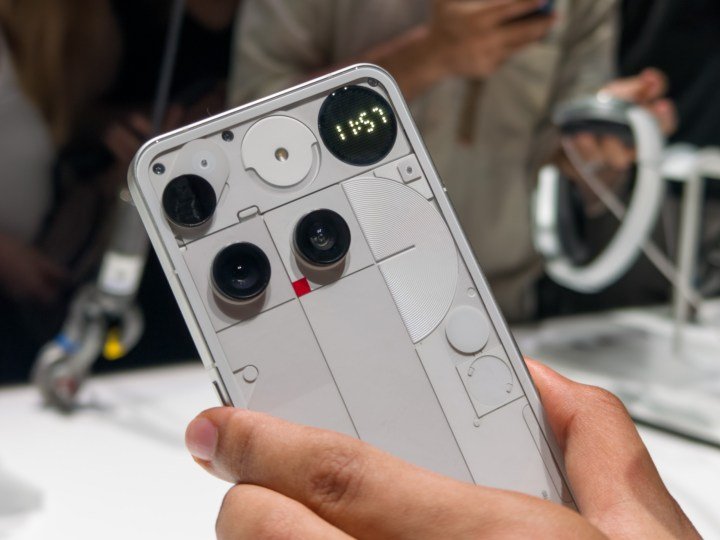
If you’ve liked the design of Nothing phones so far, you may be disappointed by the design of the Phone 3. It’s an evolution of everything to this point, but it removes the trademark Glyphs in favor of the new Glyph Matrix (more on that below).
Like past Nothing phones, the company has effortlessly blended a transparent-like shell with unique internal designs to create an effortlessly stylish phone, even if the design will divide opinions. The back and front of the phone use Gorilla Glass 7i instead of the more durable Victus, and while this will handle some light wear and tear, it doesn’t hold up as well to daily usage.

The back features an interesting triple-column layout that’s designed to help all the components feel aligned, but it fails to do so in one of the cameras. Like the 3a Pro, the Phone 3 uses an interesting camera array layout, with the main and ultra-wide cameras aligned but the telephoto camera off-center. It’s almost as if the positioning was an afterthought, and it makes the back feel a little abnormal, especially compared to most phones.
The cameras are positioned at the center and left of the top of the phone, while on the right, you’ll find a small Glyph Matrix display, complete with a capacitive button to enable it or cycle through the different Glyph toys. This button can be a bit difficult to press, but it functions flawlessly once activated. At 218 grams and measuring 9mm thick, the Phone 3 weighs the same as the Galaxy S25 Ultra but is 0.8mm thicker, yet the in-hand feel belies the actual weight of the phone.
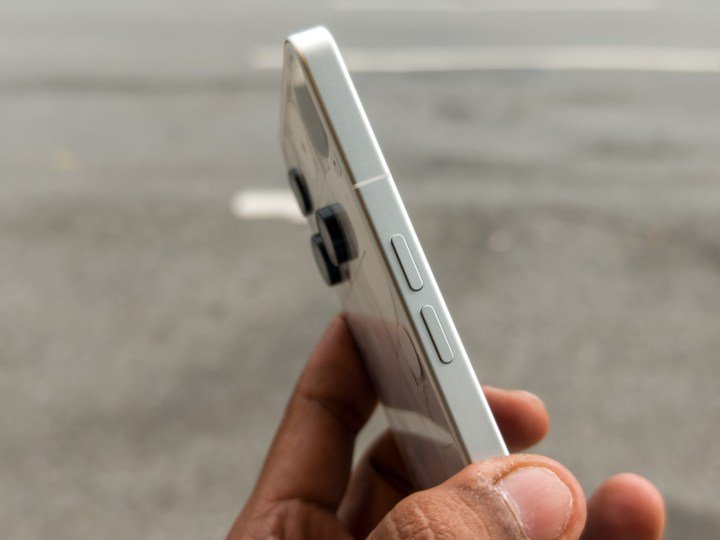
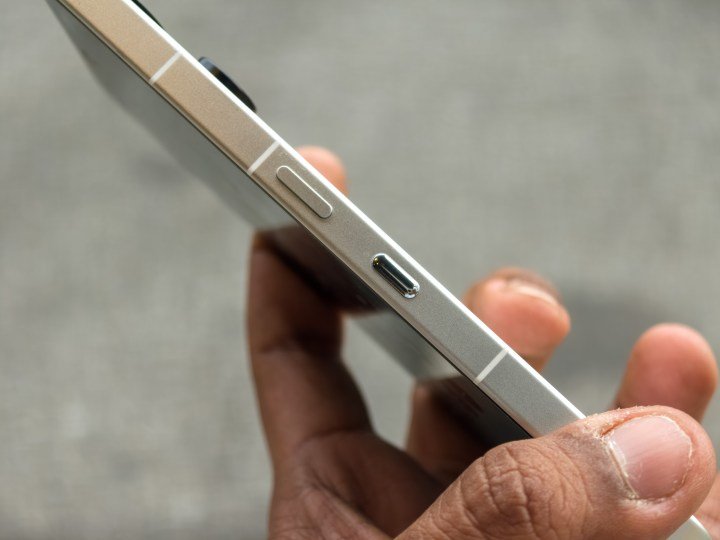
On the left side, you’ll see the volume up and down keys, but as they’re positioned in the middle of the device, they’re harder to press than on other phones. The same applies to the power and Essential keys on the right, which are also positioned in the middle and require learning the new positioning. A week into using the Phone 3, I’m still struggling to take screenshots, thanks to the positioning of the keys. This will likely improve over time, but the positioning of the keys on other phones feels infinitely more comfortable and usable.
Nothing is nothing if not consistent in its desire to illicit a feeling when you see its devices. For some people, the asymmetrical design may feel abnormal, but if you can get past this and the layout of the keys, the Phone 3 is one of the most unique smartphone designs you’ll find, excluding the best folding phones.
Nothing Phone 3: display and Glyph Matrix
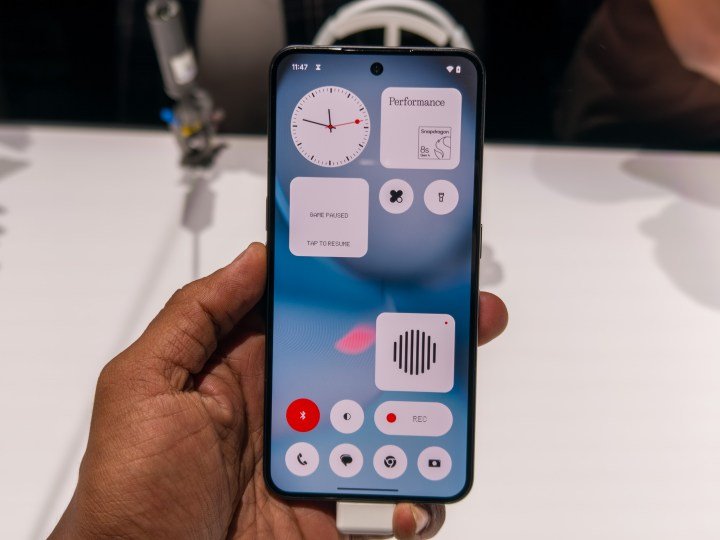
The front of the Phone 3 features a 6.67-inch OLED display with a resolution of 1,260 x 2,800 pixels, offering vibrant visuals and a peak brightness of up to 4,500 nits. It’s a joy to use in all lighting conditions, but under direct sunlight, the text becomes less legible, especially with dark mode enabled. The display also supports HDR10+ and features a 120Hz refresh rate.
Then there’s the secondary display on the rear, which is key to the Nothing Phone 3 experience and, presumably, most future Nothing phones. Rather than the Glyph LED strips of previous phones, the new Glyph Matrix is infinitely customizable thanks to 489 micro-LEDs. The result is a dot matrix display with new software features that Nothing calls Glyph Toys.

Out of the box, these include a small digital clock, a stopwatch, a battery indicator, and a fun spin-the-bottle game that can be used to decide who’s picking up the check or for other activities amongst your group. However, the Phone 3 also features other Glyph Toys that are disabled out of the box and need to be actively enabled, although the phone doesn’t tell you this.
These additional Glyph Toys include a Glyph mirror, a Rock Paper Scissors game, a Solar clock, a level, and a Magic 8-ball. The latter two are community-developed, and presumably, we’ll see additional Glyph Toys added over time.
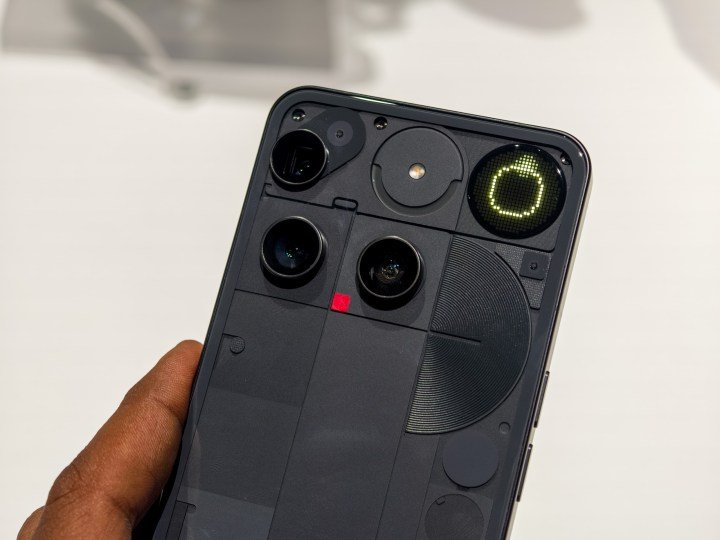
After a week of using the Phone 3, I see why Nothing changed to a Glyph Matrix, but I have reservations about how much more useful this is over the Glyph LEDs. Those were able to notify you when the phone was placed face down, which was super useful. In contrast, the new Glyph Matrix is far more capable but feels less useful, at least for now. I wish that Nothing had made the Glyph Matrix larger, but overall, it’s a nice feature to have, even if it’s missing a killer use case that makes it a must-have, at least for now.
Nothing Phone 3: Hardware & performance
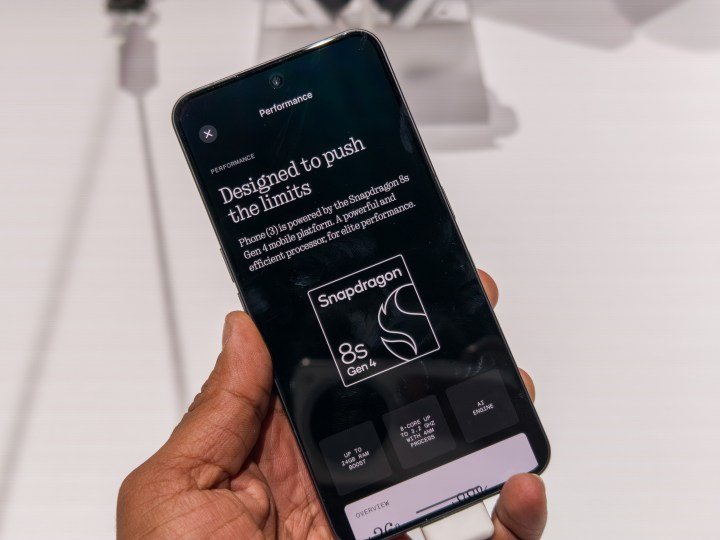
Before the launch of the Phone 3 last week, Nothing teased that this would be a true flagship smartphone. As a result, expectations were set that we would likely see a flagship processor, such as the Snapdragon 8 Elite, used by most of the best phones. Instead, Nothing chose the Snapdragon 8s Gen 4 processor, which is used in upper mid-range devices, rather than a true flagship phone.
Unfortunately, this comes as the Phone 3 is priced to compete with rival flagship phones, such as the Galaxy S25, OnePlus 13, and Pixel 9, all of which utilize flagship processors. The first two use the Snapdragon 8 Elite, while the latter uses a Tensor G4, and both processors are more performant than the Snapdragon 8s Gen 4.
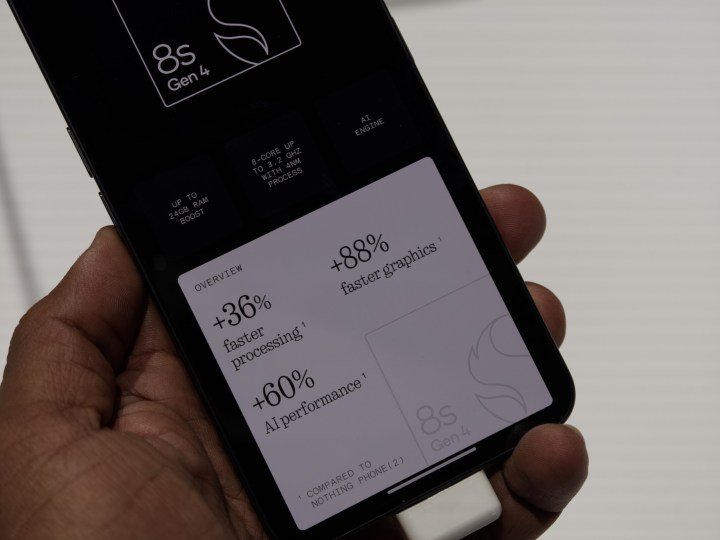
However, it’s worth noting that these are just the specs, but the Phone 3 experience feels just as smooth as any other flagship. If you don’t know that it’s running a Snapdragon 8s Gen 4, you’ll likely be pleasantly surprised at how smooth the performance is. That said, this is not a flagship chip, even when paired with 12GB of RAM and 256GB of storage or 16GB of RAM and 512GB of storage.
Beyond the processor, the Phone 3 features most of the key specs you’d also expect from a flagship phone. There’s Wi-Fi 7, 5G Sub-6 (no mmWave), and dual-band GPS. There’s also Bluetooth 6.0 support, making the Phone 3 one of the few phones to support this next-gen standard.
Nothing Phone 3: Battery life
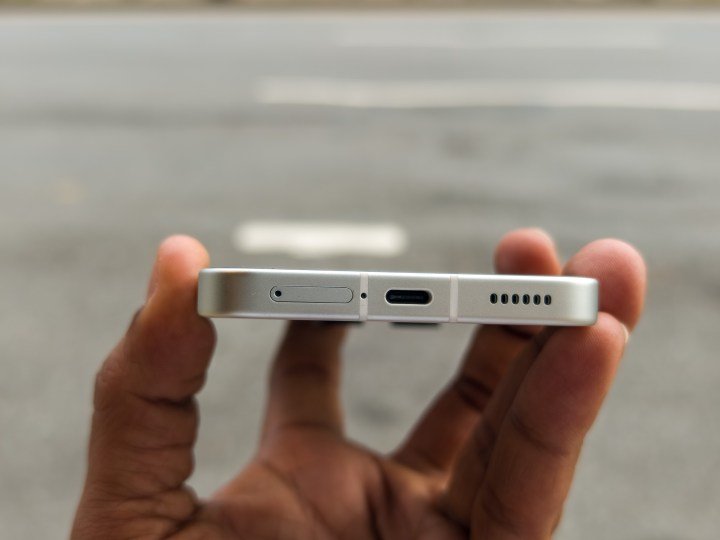
One of the benefits of choosing the Snapdragon 8s Gen 4 over the Snapdragon 8 Elite is the required power, with the latter proving to be one of the most power-hungry chipsets you’ll find.
That doesn’t mean that Nothing has made the battery smaller; rather, the opposite is true: it features a 5,150 mAh battery in the international model, paired with 65W charging, 15W wireless charging, 7.5W reverse wired charging and 5W reverse wireless charging. These specifications are on par with, or better than, those of the Galaxy S25 Ultra.
On the battery front, the Phone 3 delivers a true flagship battery experience. It lasts for multiple days on a full charge and offers between six and seven hours of screen time during this period. This device delivers excellent battery life and is designed to meet the needs of even the most demanding users. When your battery runs low, the 65W wired charging can top it up to full in an hour, which is above average as well.
Nothing Phone 3: Cameras
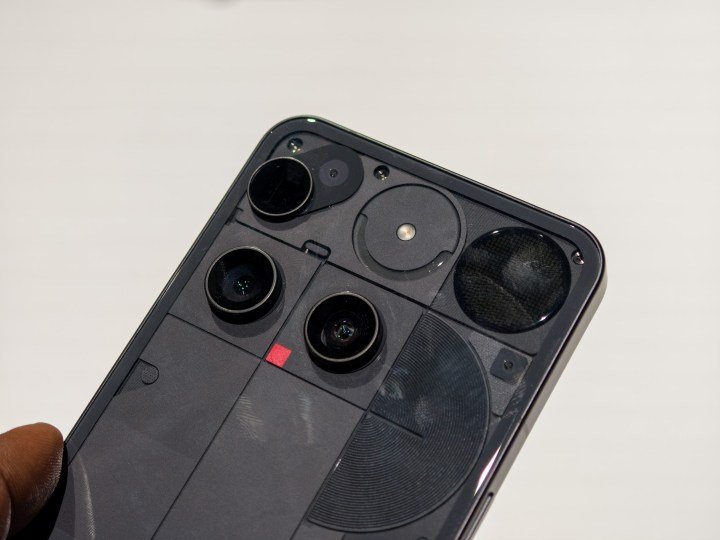
Then there are the cameras, an area where many phone makers struggle. I had expected the triple camera on the Phone 3 to be less capable than its specs suggest — especially given that phone makers struggle with algorithms and processing — but I was pleasantly surprised. Over the past week, the Phone 3 camera has proven itself to be a very capable smartphone camera.
The Phone 3 features three 50MP cameras on the rear, paired with an additional 50MP selfie camera on the front. This uniformity means that you can switch between lenses with no loss in resolution, and even though the aperture is different, there’s less of a noticeable shift than you’ll find on many of the best smartphone cameras.
The camera interface is fairly minimal, but most commonly used options are laid out in a grid, making it easy to change settings while holding the Phone 3 in one hand. There’s a distinct lack of many features and software modes that you’ll find on rival phones, but the Phone 3 excels in the basics.
As you might expect, the Phone 3 takes great photos in daylight situations with good color balance and detail. There’s no aggressive smoothing to be found on other phones, and even in low light, the camera holds its own, producing vivid images with minimal noise.




The telephoto lens offers up to 3x optical zoom, 6x hybrid zoom, and up to 60x digital zoom. The optical zoom quality is fantastic, the hybrid zoom is fairly capable, and even at the farthest focal lengths, it proves to be capable enough to make street signs legible.
The Phone 3 camera is the best of any Nothing phone to date, but it’s worth noting that it’s not as capable as many rival Chinese phones, such as the Vivo X200 Pro, Oppo Find X8, Xiaomi 15, and OnePlus 13. All of these phones outperform the Phone 3 camera, and while Nothing still has a lot to catch up on, the Phone 3 camera is an excellent step towards a true flagship camera experience.
Nothing Phone 3: Software

The Nothing Phone 3 ships with Nothing OS 3.5, which is based on Android 15. Nothing promises the Phone 3 will get five Android OS updates and seven years of security updates, but with the Android 16 stable build available for over a month, it’s surprising that the Phone 3 doesn’t run this out of the box. Instead, this update will count towards one of the Android OS updates when it is released in the coming months.
I haven’t spent extensive time with a Nothing phone before, and Nothing OS 3.5 has one of my favorite interfaces on Android.
It’s smooth, features a distinct style, and allows you to choose between a standard Android home screen and the fantastic Nothing interface, characterized by its grayscale aesthetic. While I love the Nothing interface, it’s worth noting that it makes it somewhat harder to find the app you’re looking for. Nothing’s custom widgets are also unique and add further useful features to the overall experience.
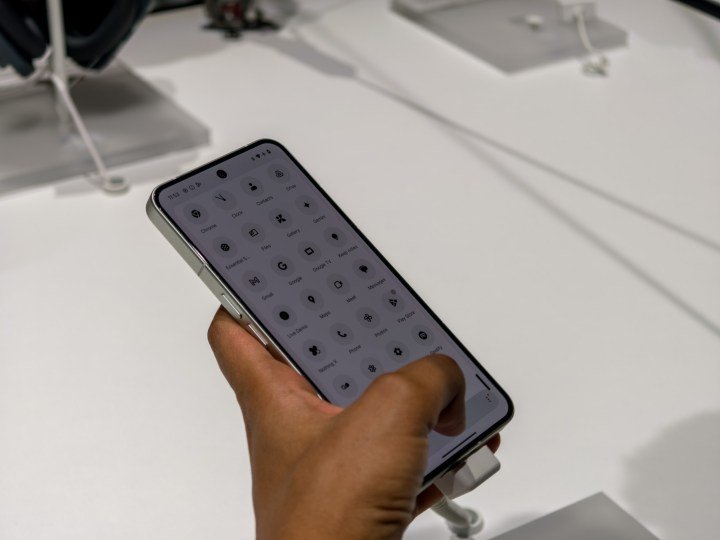
Then there’s the Essential Space, and the Phone 3 picks up where the Phone 3a and Phone 3a Pro left off. Essentially, it’s a dedicated space to store screenshots — which you can annotate with your notes or commentary — and then use AI to extract key information. It’s a fun way to store information, but it’s less capable overall than the AI key features on the OnePlus 13s or the suite of Moto AI features on the Motorola Razr Ultra 2025.
Nothing OS 3.5 offers a clean, out-of-the-box experience, but it has fewer features overall than the competition. If you’re looking for the most customizable OS, this won’t be for you, but if you want a bloat-free, fast, and smooth interface, the Phone 3 more than delivers on this experience.
Nothing Phone 3: price and availability

Nothing unveiled the Phone 3 on July 1 in London, and you can now pre-order the phone ahead of its release on July 15. While the Phone 3 will be available in many countries, like other Nothing phones, this is also the first Nothing phone to be sold in the US, at least outside of the beta program used for previous devices.
The Phone 3 comes in black or white, and the white color is, by far, my favorite, as all the unique design features stand out more.
The base model offers 12GB of RAM and 256GB of storage and costs $799 in the US, or £799 in the UK, and €799 in Europe. For $100, £100, or €100 more, respectively, you can upgrade to 16GB of RAM and 512GB of storage, which is a worthwhile addition.
Should you buy the Nothing Phone 3?
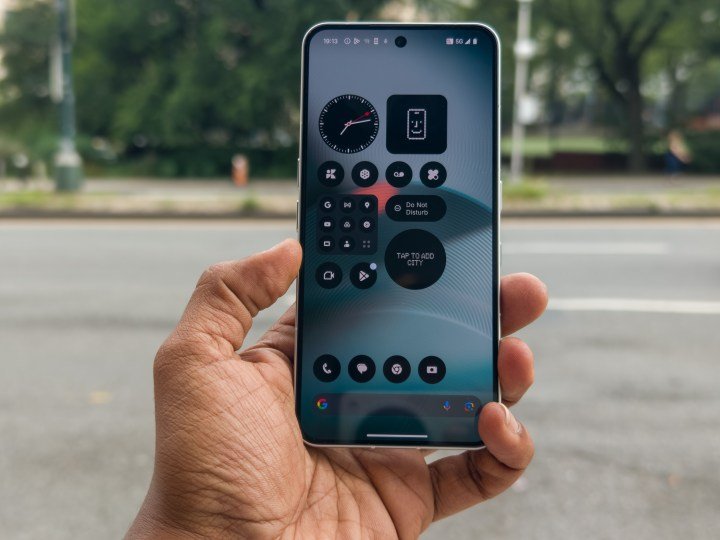
The Nothing Phone 3 is a great overall phone, and in a vacuum, it would be a great smartphone for most people. However, despite my enjoyment of the phone, it fails to deliver on Nothing’s other promise of offering excellent value for money. That’s not to say it’s a bad phone, but rather, it’s competing in the most challenging sub-market of the smartphone industry.
The biggest challenge is the overall asking price. If the Nothing Phone 3 featured a Snapdragon 8 Elite processor, it would be a great purchase for most people, but there are many phones available at lower prices with the flagship processor that we were hoping the Phone 3 would feature.
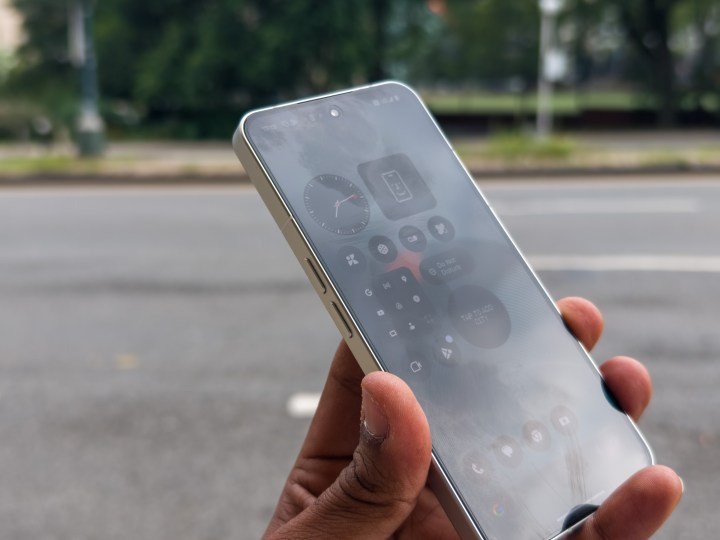
The Phone 3 does offer a unique design that has grown on me, great software, useful AI features, and the best camera on a Nothing phone to date. Yet, rival devices like the OnePlus 13 and Galaxy S25 offer this and more, and both are regularly available on sale for less than the Phone 3.
If you’re looking for a sophisticated design and a phone that helps you stand out from the crowd, the Phone 3 delivers. However, if you want a true flagship experience that can rival the best phones, the Phone 3 falls just short of that mark. It’s the best Nothing phone yet, offering a polished smartphone experience that’s uniquely Nothing. However, it’s challenging to recommend for those seeking the absolute best bang for their buck in a flagship phone.



















































